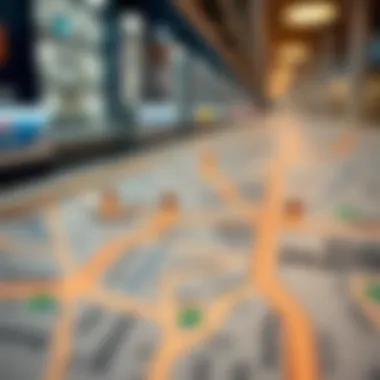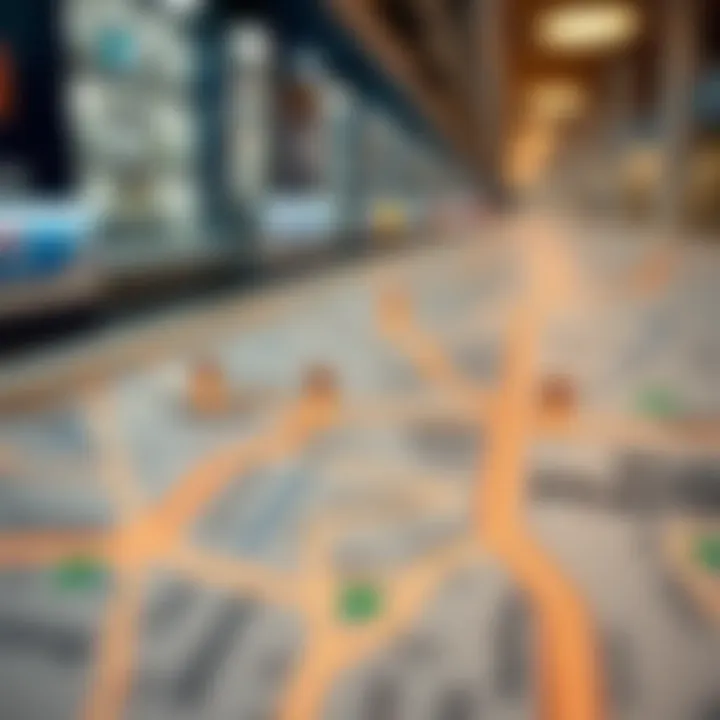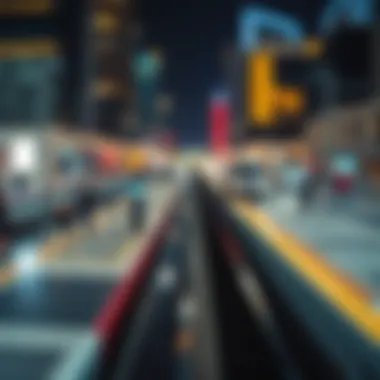Navigating the Dubai Metro Map: A Comprehensive Guide


Prelude
The bustling city of Dubai stands as a beacon of modernity, drawing the eyes and hearts of both residents and tourists from across the globe. At the heart of its intricate transportation network lies the Dubai Metro, a marvel of engineering and efficiency. Designed to alleviate the increasing traffic woes that accompany a rapidly growing metropolis, the Metro system serves as more than just a means of getting from point A to B. It connects communities, supports urban development, and significantly influences the city's ever-evolving real estate landscape.
Navigating the Dubai Metro map can be a daunting task for newcomers. With multiple lines stretching across the city, it’s easy to feel overwhelmed. This guide aims to simplify your journey, elucidating how to traverse the Metro effectively while simultaneously exploring the underlying business and property dynamics that the transit system fosters. Understanding the nuances of the Metro is not merely about catching a train; it’s about unlocking investment opportunities that can arise from burgeoning areas steadily connected by this extensive transit network.
As the discussion unfolds, we will delve deeper into the following topics, unraveling what the intricate web of the Metro map means for key urban areas and how accessibility influences property values. Investors, expatriates, agents, and savvy buyers will benefit from these insights, helping them make informed decisions in a landscape where public transport plays a pivotal role.
Market Trends
Current Property Prices
As with any booming city, real estate prices in Dubai are subject to the ebb and flow of various socio-economic factors. The rise of the Dubai Metro has undoubtedly had a hand in dictating property valuations. Areas in close proximity to Metro stations often see their real estate prices soar, as buyers and tenants alike find the convenience of public transport an appealing feature.
Currently, neighborhoods such as Downtown Dubai and Dubai Marina command premium prices due to their accessibility via the Metro. An average apartment in these areas can date back to around AED 2 million to AED 3 million, depending on size and amenities. Contrast this with areas farther from Metro access like Jumeirah Village Circle, where prices hover around AED 1 million for a similar-sized apartment. This stark contrast demonstrates how proximity to a Metro line can mean the difference between a high-value investment and a moderate one.
Future Forecasts
Looking ahead, the trajectory of property values around the Metro stations seems robust. Analysts widely anticipate that the completion of new lines, such as the Expo 2020 extension, will further inflate property values in emerging neighborhoods. The expected influx of visitors and long-term residents due to mega-events and infrastructure developments will likely drive demand.
Furthermore, regions like Dubai South and Al Quoz are on the cusp of significant transformation, with newer stations slated to open. Investors seeking high returns may find these areas ripe for development, mirroring trends from previous years when investment in Metro-adjacent neighborhoods yielded impressive returns.
"Understanding the pulse of the Metro can provide insights that extend far beyond simple transportation. It is often the pulse that drives real estate dynamics in urban settings."
Investment Opportunities
High-ROI Areas
With Dubai's dynamic real estate market, identifying areas offering high return on investment (ROI) becomes crucial. Those zoning in on neighborhoods like Business Bay, which boasts several Metro stations, may find high ROI prospects as it's becoming a hub for both work and play due to its central location and modern infrastructure. Likewise, areas around the Dubai Mall station are noted for their future potential, catering to tourists and locals alike.
Financing Options
Investors keen on capitalizing on these opportunities must also consider their financing options. Traditional avenues like mortgages remain popular; however, with the growth of alternative financing solutions like crowdfunding platforms specific to real estate—such as SmartCrowd—investors have broader access to funding. These platforms allow investors to pool their resources, thereby lowering the barrier to entry for emerging markets and neighborhoods near the Metro.
With the insights provided in this guide, one can strategically navigate the complexities of the Dubai Metro plan while simultaneously keeping an eye on real estate potentials. Understanding how public transport interfaces with property dynamics can illuminate your path, especially in a market as vibrant and fast-paced as Dubai's.
Understanding the Dubai Metro
The Dubai Metro is more than just a mode of transportation; it’s a vital thread in the fabric of the city. For residents, tourists, and business folk alike, the Metro offers a convenient, efficient, and often scenic way to traverse the expansive urban landscape. In this section, understanding the Metro is crucial for anyone looking to navigate Dubai's bustling streets with ease.
The Metro is not just about moving from point A to point B. It's about connecting people with opportunities, fostering economic growth, and playing a pivotal role in the city’s modern infrastructure. When one grasps how the Metro operates and its implications on the urban environment, they can fully appreciate its significance. This understanding also aids potential investors in identifying prime areas for real estate investments that benefit from proximity to Metro stations.
Overview of the Metro System
At first glance, the Dubai Metro system may seem like a simple network of lines and stations. However, there's much more beneath the surface. The system currently includes two principal lines: the Red Line and the Green Line, servicing both the bustling urban centers and quieter suburban areas alike.
- The Red Line stretches approximately 52 kilometers and connects key destinations like Dubai Marina and Dubai International Airport, making it a lifeline for commuters and travelers.
- The Green Line, though shorter at about 22 kilometers, interlinks vital spots like Deira and Bur Dubai, enhancing accessibility across the city.
Each station is designed to accommodate a large influx of passengers, with facilities that cater to convenience, comfort, and safety. Elevators, escalators, and well-marked pathways ensure that everyone, including those with disabilities, can navigate the stations effortlessly. The aesthetic design of the Metro stations also incorporates elements of traditional Emirati culture, offering a glimpse into the city's rich heritage.
History of the Dubai Metro
The conception of the Dubai Metro was born out of necessity. As the city rapidly modernized, the challenge of urban congestion became evident. Planning for the Metro system began in the early 2000s, driven by the need for a reliable public transport system to alleviate traffic woes and reduce dependency on automobiles.
The first line of the Metro was inaugurated in 2009, and since then, it has seen several expansions and upgrades. Initially as a significant achievement in engineering and design, it paved the way for future transportation projects across the emirate. Hence, the history of the Dubai Metro mirrors the development of the city itself—fast-paced, ambitious, and always looking ahead.
Understanding this history is essential for investors and analysts; it reveals the city's commitment to sustainability and modernity. The Metro not only serves as a transportation solution but has also transformed the real estate landscape along its routes, encouraging more people to consider living and working in Metro-connected locations.
"The Dubai Metro is more than a transport system; it's a catalyst for growth and a symbol of modern Dubai, reshaping how we interact with the city."
By comprehending the basic framework and historical context of the Dubai Metro, stakeholders can better appreciate its role within the urban environment and its implications for future developments.
As we move forward, each facet of the Metro will unfold, providing deeper insights into its operational efficacies and the opportunities it presents.
The Structure of the Metro Map
Understanding the structure of the metro map is essential for anyone looking to navigate the Dubai Metro efficiently. This intricate network connects various districts and key hubs, making it a linchpin in the city’s public transport system. Without a grasp of how the lines and stations fit together, commuters—and especially potential investors—might miss out on valuable insights regarding real estate dynamics. The metro map isn’t just a guide for getting from point A to point B; it’s a visual representation of connectivity, accessibility, and, importantly, opportunity.
Lines and Stations Explained
The Dubai Metro comprises two main lines: the Red Line and the Green Line, each with their distinct characteristics. The Red Line runs along the city’s spine, stretching from Rashidiya to UAE Exchange, facilitating access to key locations such as the Dubai Mall and the Burj Khalifa. The Green Line, on the other hand, runs perpendicularly, stretching from Etisalat to Dubai Creek. Each line hosts multiple stations designed with user experience in mind. This design minimizes transfer times and maximizes ease of access, which is critical for busy city dwellers and tourists alike.
Here's a deeper dive into the lines:


- Red Line Stations: Each station acts as a hub, integrating commercial developments and attracting foot traffic. For instance, the Mall of the Emirates station connects directly to a shopping center that boasts an indoor ski slope, illustrating how the metro fosters economic activity.
- Green Line Stations: These often link local neighborhoods to the more affluent tourist districts. Stations like Al Jafiliya and Oud Metha cater to both daily commuters and visitors, supporting local businesses and enhancing community engagement.
Understanding the positioning of these stations can reveal lucrative investment opportunities. Properties near key stations can see an increase in demand, impacting property values positively.
Interconnecting Routes
Interconnecting routes are the arteries of the metro map. They allow passengers to switch between lines seamlessly, enhancing the usability of the entire transport system. Notably, major transfer stations like Burjuman and Union Square serve as crucial junctions where passengers can easily switch from the Red Line to the Green Line.
The importance of interconnecting routes cannot be overstated. They simplify travel, which is a significant advantage for businesses looking to attract customers from various regions. Moreover, properties situated near these interchanges tend to gain more traction in the real estate market. Investors often look for locations that promise growth, and proximity to these connections can lead to higher long-term ROI.
To put this into perspective, here are some key considerations:
- Daily Commuters: A well-connected metro line means that commuting can be quicker and less stressful, thus enhancing local quality of life.
- Accessibility to Attractions: Interconnecting routes ensure that attractions are within reach for both residents and tourists, incentivizing spending and further propelling the local economy.
"Public transport isn't just about getting from A to B; it's about creating connections, both socially and economically."
Overall, the structure of the Dubai Metro map does more than support mobility; it shapes the urban landscape. By understanding its layout and functionalities, investors and commuters alike can make better-informed decisions about navigating both the city and its real estate opportunities.
Key Stations on the Metro Map
The Dubai Metro system is an lifeline that stitches together the urban fabric of Dubai. It isn’t just about getting from Point A to Point B; it’s about connecting people, diverse communities, and economic opportunities. The key stations on the metro map are more than mere stops; they are vibrant hubs that reflect the city’s dynamic lifestyle and growing real estate landscape. Understanding these stations enriches one’s experience while also offering a keen perspective on investment potentials and accessibility.
Major Hubs and Transfer Stations
In a city that thrives on movement, the major hubs and transfer stations of the Dubai Metro play a pivotal role in easing transit for passengers. The centerpiece is undoubtedly Union Station, which connects the Red and Green lines. This busy interchange not only increases travel efficiency but also hosts several amenities, such as shops and eateries, making it a bustling locale throughout the day.
Another significant hub is BurJuman Station, strategically located near prominent shopping venues. This transfer point allows for a smooth transition between metro lines, encouraging Patronage and increasing foot traffic to nearby retail establishments. The Dubai Mall Station also earns its merits by providing access to one of the world's largest shopping malls, further making it vital for both residents and tourists.
These stations serve as gateways, facilitating further explorations of Dubai, and also hint at the broader trend of property value increases in their vicinity. Areas surrounding these major hubs tend to attract higher interest, creating lucrative investment opportunities for both local and international buyers.
Landmarks Accessible via the Metro
The accessibility of significant landmarks via the metro offers a unique opportunity for residents and tourists alike to explore the multifaceted offerings of Dubai. For instance, the Mall of the Emirates Station allows easy access to the iconic Mall of the Emirates, renowned for its indoor ski slope, which is an unparalleled attraction.
Similarly, the Dubai Marina Station positions travelers close to the tranquil waterfront, vibrant nightlight, and fine dining establishments that this area is famous for. The Dubai World Trade Centre Station gives access to several high-profile events and exhibitions, further emphasizing the metro’s importance in connecting people with opportunities.
Moreover, the Khalifa Park and the Dubai Aquarium are just a short metro ride away from designated stations, enhancing the cultural exploration and lifestyle options available to residents.
These landmarks not only enrich the lives of people residing nearby but also serve as magnets for investors eyeing commercial and residential properties within these thriving areas.
"The convenience of the Dubai Metro extends far beyond the tracks; it's about the communities and landmarks it connects."
As you navigate the Dubai Metro, recognizing the strategic significance of its key stations can empower you, whether as an investor seeking the next lucrative opportunity or as a resident wanting to access the city’s vibrant spots effortlessly. By carefully mapping out routes and highlights, you can better understand the intricate relationship between public transport and real estate in this bustling metropolis.
The Importance of Metro Accessibility
Metro accessibility in Dubai is not just about hopping on a train; it's a gateway to a multitude of opportunities for residents and investors alike. An accessible metro system serves as a backbone for urban mobility, connecting various neighborhoods, commercial centers, and key landmarks, which leads to a flourishing economy and vibrant community. The ease of getting from point A to point B becomes a significant factor in defining where people choose to live and invest.
Impact on Property Values
It's clear that access to the Dubai Metro has a direct impact on property values. Properties located near metro stations often command higher prices due to the convenience they offer. Residents recognize the value of having a reliable transport option at their doorstep. For instance, areas adjacent to the Mall of the Emirates and Dubai Marina stand testament to this trend. Not only do these properties enjoy premium pricing, but they also see a consistent demand, making them attractive options for investors.
Further extending this idea, think of the ease of commuting when considering a property. A family who can zip into the city in mere minutes is more likely to prefer a home near the metro. This change in behaviour makes spots near these stations desirable not just for families but for an entire demographic spectrum, including young professionals and expatriates, who wish to balance work and leisure seamlessly.
Attractiveness to Investors
Investing in properties close to the metro isn't just about current demand; it's also a strategic move for the future. Understanding this relationship can unlock lucrative opportunities.
Comparative Analysis of Metro-Proximate Areas
When you compare neighborhoods that are well-served by the metro against those that aren’t, the differences tell a compelling story. For instance, take the contrast between Jumeirah Village Circle and Downtown Dubai. While both areas are developing rapidly, the latter has the luxury of immediate metro access. Such proximity elevates its appeal, which often translates into brisker sales and a higher likelihood of property value appreciation.
Key features like proximity to commercial hubs, schools, and hospitals amplify the attractiveness of metro-accessible regions. Ultimately, investing in these neighborhoods often leads to higher returns, making them a popular choice for savvy investors entering the Dubai market.
Investment Potential in Emerging Neighborhoods
Emerging neighborhoods, particularly those plotting future metro expansions, present a goldmine for current and potential investors. Locations that are on the cusp of development often have lower initial property prices, with projections for significant growth once the metro system is established.
Imagine snagging a property now in an area like Dubai South, soon to be blessed with new metro lines. Such investments might yield remarkable long-term benefits. The uniqueness here lies in the potential for an initial lower buy-in price with considerable appreciation expected as infrastructure improves, solidifying this area's value.
In summary, the interplay between metro accessibility and property values cannot be overstated. As the Dubai Metro continues to expand, areas connected to its lines will undoubtedly surge in desirability, cementing their role as prime investment targets.
"In the ever-changing landscape of Dubai's real estate, proximity to transportation is king."


This nuanced understanding of metro accessibility and its correlating effects sets the stage for informed decision-making in property investments. For a deeper dive into practical aspects, consider referencing resources like Wikipedia or Britannica for detailed insights.
Future Expansion Plans for the Metro
The ongoing evolution of the Dubai Metro system reflects the city's ambition to develop a world-class public transport infrastructure that meets the needs of its growing population and economic landscape. As Dubai continues to attract expatriates, tourists, and businesses, future expansion plans for the Metro are not just enhancements; they're essential steps to maintain the system's relevance and efficiency. Crucially, such expansions are more than mere additions of routes; they represent strategic moves that address current demands and anticipate future needs.
Upcoming Lines and Extensions
The Dubai Metro is set at an interesting intersection of modernization and urban sprawl. Upcoming lines and extensions promise to interconnect areas that have traditionally struggled with accessibility. For instance, plans include extending the Red Line further south, linking communities that have popped up in recently developed areas. Similarly, the Blue Line is projected to run towards areas that have recently erupted with residential towers and commercial spaces, thus minimizing travel times significantly.
Expansion plans frequently align with broader urban development initiatives. The new routes are designed to serve not only residential districts but also commercial hubs, logistics zones, and even tourist hotspots. Potential links to Al Maktoum International Airport and the Expo 2020 site—though the Expo has ended, its legacy will live on—would undoubtedly increase footfall through these stations, providing passengers easy access to key destinations.
Greater capacity measures are equally in motion; the anticipated extensions aim to alleviate current overcrowding and ensure smooth operational flow. By anticipating the needs of the future, these expansions will help the Metro keep pace with Dubai's rapid expansion.
Projected Impact on Real Estate
The projected impact on real estate cannot be understated, as Metro expansions have historically catalyzed significant shifts in property values. Areas adjacent to new stations often see a spike in demand, as access to efficient public transportation becomes increasingly desirable. Investors and homeowners alike recognize that proximity to the Metro translates to a convenience that can elevate property marketability.
Furthermore, developments in neighborhoods that are newly served by Metro routes can lead to a diversity of commercial opportunities. With more accessible locations, properties might shift from simply residential to mixed-use, attracting cafes, shops, and even office spaces. The correlation between Metro accessibility and increased property values is evident, with several studies suggesting that homes within a half-mile radius of a Metro station enjoy faster appreciation rates compared to their counterparts further away.
"Invest in areas close to Metro lines. The returns often speak volumes."
As urban sprawl continues, these developments help shape the city—making it sustainable yet accommodating for the influx of newcomers. The continued rise in property values, along with increased investor interest, emphasizes the need for strategic planning in future expansions. In this context, it's vital for stakeholders to understand how these changes could shape market dynamics in the coming years.
In summary, the future of the Dubai Metro stands as a proactive approach not just to transportation, but also to real estate dynamics, connecting the dots—literally and figuratively—between people and opportunity.
Navigating the Metro System
The Dubai Metro is a unique blend of modern convenience and cultural significance, making it essential for both residents and visitors. This system of railways is more than just a means to travel; it’s a conduit for the daily rhythms of urban life in one of the world's most dynamic cities. Understanding how to navigate this network is crucial, especially for investors, expatriates, and those considering buying property in Dubai.
Buying Tickets and Fare Structure
Getting on board the Dubai Metro begins with understanding the ticketing and fare structure. The system employs a simple yet effective method for fare calculation, categorized based on travel zones. Each journey incurs a fee that corresponds to the number of zones traversed. This tiered pricing system encourages commuters to plan trips efficiently, minimizing unnecessary costs.
Tickets can be purchased at vending machines located in every station or via the Nol Card system, which offers a more streamlined experience.
- Types of Tickets:
- Single Journey Ticket
- Day Pass
- Nol Card (the most convenient option)
The Nol Card holds a significant place in the heart of this transportation system. It isn’t just a means of entry, but a multifunctional card that can also be utilized for buses and water taxis, enhancing the travel experience across the board. It’s quite handy to preload funds on your card and forget about buying tickets for each ride. Also, it offers discounts for frequent travelers.
When budgeting for a journey, regard factors like peak hours and special events, as these can affect both availability of trains and waiting times at stations.
User Experience and Accessibility Features
The Dubai Metro prides itself on its user-friendly design, catering to a diverse range of passengers. Accessibility isn’t an afterthought; it’s an integral part of the Metro’s infrastructure. Ramps, elevators, and designated spaces for wheelchairs make travel less daunting for those with mobility challenges. Special care has even been taken for the elderly, with seating areas prioritized for them.
Traveling during rush hours might seem overwhelming, but efficient crowd management systems, such as designated women-only cars during peak times, ensure that everyone feels secure.
- Key Features Improving User Experience:
- Real-time updates on train timings
- Clean and well-maintained stations
- Free Wi-Fi access throughout the metro network
Moreover, signage is clear and multilingual, allowing those new to the city to navigate with confidence. Digital displays throughout the stations make it easy to track arrivals and departures.
In an environment where technology meets urban transport, the high-speed rail not only shortens travel time but also elevates the entire commuting experience. The Dubai Metro is not merely a transportation system; it is a critical player in the city’s identity, connecting cultures and communities.
"The Metro is the lifeline of Dubai, offering an accessible, efficient means for people to connect and explore this vibrant city."
Ultimately, navigating the Dubai Metro isn't just about getting from A to B; it’s about embracing the lifestyle that comes with urban connectivity. For any budding investor or curious traveler, mastering this system opens doors to understanding the larger tapestry of what Dubai has to offer.
Challenges and Limitations
The Dubai Metro, while a commendable addition to the city’s transportation framework, grapples with its own set of challenges and limitations. Understanding these issues is crucial for stakeholders, including investors and residents, as they navigate the evolving urban infrastructure.
Issues of Overcrowding
A key challenge facing the Dubai Metro is overcrowding, especially during peak hours. Despite its extensive reach, the sheer volume of commuters can lead to packed carriages, creating a cramped travel environment. This situation often discourages potential users, particularly tourists who might find the experience less than inviting. The significant number of daily passengers, coupled with rapid population growth in urban areas, can exceed the Metro's designed capacity at various times.
Moreover, commuter rushes typically occur during weekdays, making the commute a test of patience for many. For residents who depend on the Metro to get to work or school, this can mean lengthy waits for services, as trains are often not as frequent during rush hours. In essence, overcrowding can diminish the perceived value of this efficient transport system, further complicating urban mobility in Dubai.
To counteract this, the metro authorities might consider strategies like increasing train frequency during peak times, improving marketing around off-peak usage, and promoting alternative routes.


Capacity vs. Demand
Capacity vs. demand is another pressing issue that needs addressing. On one hand, the Dubai Metro boasts a high carrying capacity, designed to transport thousands of passengers simultaneously. On the other hand, the constant inflow of residents and visitors can challenge this capacity. The demand for rides can fluctuate dramatically based on time of day, special events, and ongoing cultural shifts within the city.
As the population continues to swell, the existing infrastructure faces strains, creating a potential bottleneck effect. This mismatch can discourage usage, especially among those seeking reliable transportation alternatives. The challenge lies not only in accommodating present demands but also in anticipating future needs. The logistics of expanding infrastructure to manage demand can turn into a juggling act for city planners.
Here are some considerations on how to approach the issue:
- Conduct detailed studies on passenger volume trends to better predict peak times.
- Explore options for expanding service, including adding new lines or stations that serve high-demand areas.
- Consider implementing solutions like mobile apps for real-time updates on train availability and crowd levels to help commuters plan better.
As the Dubai Metro continues to evolve, addressing these challenges will be imperative to maintaining its role as a linchpin in the city’s urban landscape.
The Role of Technology in Metro Operations
The integration of advanced technology into the operations of the Dubai Metro is indispensable. This system not only enhances the overall efficiency of metro services but also enriches the passenger experience. As the urban landscape evolves, so does the need for innovative transportation solutions. To this end, the application of smart technologies and data analytics stands out as crucial components that define the performance and reliability of the metro. This section explores the significant roles these elements play, shedding light on how they influence the operation and management of this dynamic transport system.
Smart Technology in Modern Transport
At the heart of modern transport systems, particularly the Dubai Metro, is the concept of smart technology. This includes numerous innovations such as automated ticketing kiosks, real-time train tracking, and contactless payment systems. These features make travels easier and more efficient for passengers.
- Automated systems: The metro uses automation extensively for various operations such as train scheduling and maintenance. This reduces human error and enhances safety.
- Mobile applications: Recent investments into mobile app development allow riders to track trains in real-time, plan their journeys effectively, and even receive updates on service interruptions.
- Smart cards: The Nol card system is another example; it streamlines the fare process and offers discounts for regular users. The technology facilitates fast boarding, reducing waiting times at stations.
The advantages of these smart technologies can be felt on a daily basis. Passengers find their journeys smoother, largely due to reduced wait times and increased reliability of service. In addition, technology enables operational staff to monitor performance indicators closely, allowing for timely interventions and adjustments.
Data Analytics for Performance Improvement
Data analytics offers another layer of sophistication in metro operations. By harnessing the power of big data, the Dubai Metro can assess patterns in ridership, maintenance needs, and operational efficiency. Thoughtful analysis translates into enhanced strategies for performance and development.
- Demand forecasting: Predicting peak times helps in allocating resources more effectively. For instance, if data shows increased riders on Thursday evenings, additional trains can be scheduled to accommodate the surge.
- Maintenance scheduling: Through predictive analytics, the network can preemptively address equipment failures before they lead to service disruptions. This method not only prolongs the lifespan of assets but also enhances the safety of the riding experience.
- Performance optimization: By reviewing operational data, officials can identify areas where efficiency can be enhanced. This might include adjusting train frequencies or modifying routes to better serve commuter needs.
The synergy of smart technology and data analytics creates a more agile and responsive metro system, capable of adapting to the ever-changing demands of a bustling city.
In summary, the role of technology, be it through smart systems or analytical insights, cannot be understated in the context of the Dubai Metro. The advantages go beyond simple convenience; they forge a more adaptive and resilient transportation framework essential for the city’s ongoing growth and modernization.
Cultural and Social Aspects of the Metro
The Dubai Metro is not just a means of transportation; it represents a blend of culture and social interaction that shapes the urban experience for residents and visitors alike. Understanding its cultural and social aspects provides insights into how this system fosters a unique community feel while also responding to the fast-paced lifestyle of a metropolitan area.
Establishing a reliable public transport system like the Metro has helped to cultivate a sense of connectedness within a city that often appears sprawling and busy. Its role as a facilitator of daily life extends beyond sheer convenience—for many, it serves as a meeting point, a venue for casual encounters, and a space where diverse cultures intermingle. Here lies the real heart of Dubai: a mosaic of communities that thrive in the rhythm of urban mobility, adapting and sharing experiences through their daily commute.
Metro as a Social Space
The Dubai Metro serves as a social space in more ways than one. The very design of the trains and stations encourages interaction among passengers. Eloquent and practical, the spaces are often bustling with people from different backgrounds, each contributing to a vibrant atmosphere.
In the heavily air-conditioned carriages, one might overhear snippets of conversation in various languages, bearing testament to the city's multicultural makeup. From expatriates to tourists on a visit, the Metro creates an environments that promotes sharing stories and experiences. These interactions enrich the social fabric of Dubai, transforming an ordinary commute into a shared journey.
- Community Engagement: Special events and festivals are sometimes hosted at major stations, turning these transit points into cultural hubs.
- Informal Networking: Many professionals utilize the Metro for their daily commute, opening up opportunities for collaborations over casual chats on the journey.
Art and Design in the Metro Environment
Art and design form a cornerstone of the Dubai Metro experience, contributing to a visually stimulating environment. The stations are often adorned with artworks that reflect the spirit and heritage of the UAE.
- Murals and Installations: Each station features unique art installations and murals that tell stories—from the rich history of the Emirates to modern interpretations of its culture.
- Architectural Features: The design of the Metro system itself is a synthesis of functionality and artistic expression, blending modern aesthetics with traditional elements. Many passengers find their journeys visually enriching due to these thoughtful touches.
The integration of art into the Metro environment provides a dual benefit—enhancing user experience while promoting local artists and their work.
"The Metro is not just about getting from point A to point B; it is an art gallery on wheels, where daily life meets culture."
These cultural attributes of the Metro not only make travel more pleasant but also emphasize the importance of arts in urban planning. Through this focus, Dubai builds a stronger identity, providing a sense of belonging for those who traverse its routes daily.
Closure and Key Takeaways
In the bustling context of Dubai, the Metro system stands as not merely a mode of transportation but a critical catalyst for urban development and real estate growth. As we've explored throughout this guide, understanding the dynamics of the Dubai Metro map sheds light on its integral role in shaping the city’s landscape. This section serves to encapsulate the significant points discussed, reinforcing the Metro’s impact on daily commutes, investment opportunities, and urban planning.
Summing Up the Metro's Impact
The Dubai Metro has transformed how residents and visitors traverse the emirate. Its efficiency not only eases the daily grind of commuting but also enhances connectivity among various neighborhoods. As the city expands, Metro stations frequently align with emerging commercial and residential developments, making them prime spots for property investment. For investors and buyers alike, the value of being situated near a Metro station is of paramount importance. It represents convenience, accessibility, and potential growth, turning previously overlooked areas into attractive prospects for purchase.
Of notable mention is how the Metro system supports economic activities. By facilitating access to key commercial hubs, the system dovetails with Dubai's ambitions to be a leading global business center. Failing to recognize the Metro’s role in shaping these opportunities could lead to missed chances for savvy investors and developers.
“The Metro is more than just a transport system; it’s a lifeline that connects people to opportunities.”
Future Prospects for Dubai's Transportation Landscape
Looking ahead, the future of Dubai's transport ecosystem appears promising. Planned expansions of the Metro system indicate that authorities are keen on maintaining the momentum of growth. With up-and-coming lines and extensions in the pipeline, we can expect not only improved access to more parts of the city but also enhanced passenger capacity as demand spikes.
As new neighborhoods develop, the Metro will likely respond by adding routes that facilitate easier commuting to these areas, thereby increasing their appeal to potential buyers and investors. The government's commitment to sustainable transportation solutions positions the Metro as a cornerstone in reducing traffic congestion and promoting an eco-friendly urban environment.
Moreover, the integration of innovative technologies like smart ticketing systems and real-time tracking adds a layer of convenience that will redefine user experience. This convergence of technology and transportation will only further increase property values in Metro-adjacent locales as the demand for accessibility and sustainability grows.



